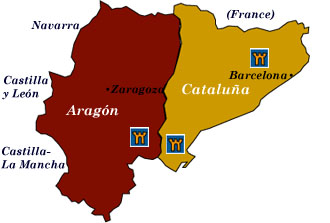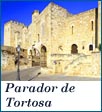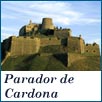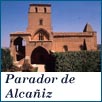Castle Hotels of Cataluña and Aragón

![]() Parador de Alcañiz
Parador de Alcañiz
![]() Parador de Cardona
Parador de Cardona
![]() Parador de Tortosa
Parador de Tortosa
Haven’t decided on a hotel yet? You can look at other available hotels in the regions of Cataluña and Aragón with Booking.com
Often overlooked for the brilliant attractions of Barcelona, an exploration of the region of Cataluña reveals splendid Roman ruins and Romanesque churches, enchanting villages and remote monasteries. Within a few hours you can leave a sun-splashed beach and find yourself surrounded by majestic mountains. And don’t forget to stop off at a vineyard for a wine tasting along the way.
Cataluña has close cultural and linguistic ties with southern France. For 900 years its identity has remained unique—to the point where you feel you’re in a separate country, as the proud Catalans would have you believe.
Covering nearly 10% of Spain’s land area, Aragón’s scenery is wonderfully diverse from the snowcapped peaks of the Pyrenees of the north, to dry wheat fields, and the pine forests of the south. Aragón remains relatively undervisited ensuring a peaceful visit.
Go to a Different Region
Andalucia
Castilla La Mancha
Castilla y León
Extremadura
Galicia
Madrid
País Vasco and Navarra
Some great reasons to visit
![]() Barcelona What’s not to like about this vibrant and dynamic world city with its 2000-year history, Mediterranean sunshine, and contemporary flair? To begin, soak up atmosphere on Barcelona’s most famous street La Rambla. This broad pedestrian avenue is lined with sidewalk cafés and restaurants with street performers, strollers, and flower sellers at every turn.
Barcelona What’s not to like about this vibrant and dynamic world city with its 2000-year history, Mediterranean sunshine, and contemporary flair? To begin, soak up atmosphere on Barcelona’s most famous street La Rambla. This broad pedestrian avenue is lined with sidewalk cafés and restaurants with street performers, strollers, and flower sellers at every turn.
Just east of La Rambla is the Barri Gòtic, the classic old quarter with winding streets, tiny plazas, and major monuments such as the Catedral (La Seu). Also highly atmospheric is the neighboring La Ribera district, home of the Museu Picasso and the Museu Barbier-Mueller d’Art Precolombí, which houses one of the most superb collections of pre-Colombian art in the world.
Barcelona also closely identifies with the revolutionary and surrealist architect Antoni Gaudí, whose work can be seen in the Parc Güell, the Casa Milà, the Casa Batlló, and culminating in the fantastic Sagrada Familia cathedral.
Finally, to take a break from the city, ride the cable car or funicular railway to Montjuïc and spend a day among its gardens, enjoying the panoramic view and visiting sports facilities from the 1992 Olympics and the Museu Nacional d’Art de Catalunya, which displays one of the greatest collections of Romanesque art in Europe, and the Fundació de Joan Miró, the main gallery presenting the work of the great 20th-century Catalan artist Joan Miró. In the southeast section of the park is a castle, which now houses the Museu Militar.
![]() Costa Brava Intimate coves, beaches, sheer cliffs, and picturesque villages punctuate the rugged stretch of coastline north of Barcelona to the French border. The whitewashed villages of Cadaqués (with its association with 20th-century surrealist artist Salvador Dalí) and the walled town of Tossa de Mar are high on atmosphere. Just inland from the coast are the beautifully preserved, medieval stone villages of Pals and Peratallada.
Costa Brava Intimate coves, beaches, sheer cliffs, and picturesque villages punctuate the rugged stretch of coastline north of Barcelona to the French border. The whitewashed villages of Cadaqués (with its association with 20th-century surrealist artist Salvador Dalí) and the walled town of Tossa de Mar are high on atmosphere. Just inland from the coast are the beautifully preserved, medieval stone villages of Pals and Peratallada.
![]() Montserrat Dramatically situated in the cleft of a “serrated” mountain, the vast monastic complex of (Monestir de) Montserrat has attracted pilgrims for a 1000 years. They come to pay homage to La Moreneta, a carved wooden statue of the Black Virgin and the patroness of Cataluña. Among the attractions here are the breathtaking mountain views, hiking trails, art treasures, and the oldest boys choir of Europe.
Montserrat Dramatically situated in the cleft of a “serrated” mountain, the vast monastic complex of (Monestir de) Montserrat has attracted pilgrims for a 1000 years. They come to pay homage to La Moreneta, a carved wooden statue of the Black Virgin and the patroness of Cataluña. Among the attractions here are the breathtaking mountain views, hiking trails, art treasures, and the oldest boys choir of Europe.
![]() Figueres The singular attraction in this otherwise unremarkable town is the Teatre Museu Dalí, not exactly a museum but an insight into the fantastical creativity of Figueres’s native son, Salvador Dalí.
Figueres The singular attraction in this otherwise unremarkable town is the Teatre Museu Dalí, not exactly a museum but an insight into the fantastical creativity of Figueres’s native son, Salvador Dalí.
![]() Wineries of Penedès Cataluña produces 1/3 of Spanish wine, and its specialty is cava, or sparkling wine, followed by Spanish whites and reds. Several wineries (Miguel Torres, Bodegas Pinord, and Castillo Perelada) in the region offer tours, but you must book ahead. You will also need your own transportation.
Wineries of Penedès Cataluña produces 1/3 of Spanish wine, and its specialty is cava, or sparkling wine, followed by Spanish whites and reds. Several wineries (Miguel Torres, Bodegas Pinord, and Castillo Perelada) in the region offer tours, but you must book ahead. You will also need your own transportation.
![]() Roman ruins of Tarragona The largest and oldest Roman settlement on the Iberian peninsula, a “Circ Roman,” or chariot stadium that once held 30,000 people, a massive temple, which has since been incorporated into a Romanesque cathedral, a restored amphitheater, and a magnificent aqueduct are all open to visit. Start your visit at the Museo Arqueològic to view artifacts discovered in the area.
Roman ruins of Tarragona The largest and oldest Roman settlement on the Iberian peninsula, a “Circ Roman,” or chariot stadium that once held 30,000 people, a massive temple, which has since been incorporated into a Romanesque cathedral, a restored amphitheater, and a magnificent aqueduct are all open to visit. Start your visit at the Museo Arqueològic to view artifacts discovered in the area.
![]() Pyrenees of Cataluña Not as wild as the mountains extending to the west, you’ll find fortified medieval villages, remote monasteries, and the Parque Nacional d’Aigüestortes with its hiking trails that wind past lakes, waterfalls and and fir forests. Some of Spain’s best ski resorts are in the Catalonian Pyrenees.
Pyrenees of Cataluña Not as wild as the mountains extending to the west, you’ll find fortified medieval villages, remote monasteries, and the Parque Nacional d’Aigüestortes with its hiking trails that wind past lakes, waterfalls and and fir forests. Some of Spain’s best ski resorts are in the Catalonian Pyrenees.
ARAGON
![]() Pyrenees of Aragón The Pyrenees of Aragón are higher, wilder, and more rugged than the mountains in Navarra or Cataluña. Valleys, lakes, and gorges cut through the unspoiled region. The Parque Nacional de Ordesa y Monte Perdido is filled with nature at every turn, creating a perfect hiking destination. The town of Benasque is a good place to start.
Pyrenees of Aragón The Pyrenees of Aragón are higher, wilder, and more rugged than the mountains in Navarra or Cataluña. Valleys, lakes, and gorges cut through the unspoiled region. The Parque Nacional de Ordesa y Monte Perdido is filled with nature at every turn, creating a perfect hiking destination. The town of Benasque is a good place to start.
![]() Mudéjar architecture During the reconquest of Spain, those Muslims who remained in the territory now occupied by Christians became known as Mudéjars. they developed a distinct architectural style that utilized brick, plaster, and colorful ceramics. The best places to see Mudéjar architecture are the Palacio de Aljafería in Zaragoza and the five Mudéjar towers of Teruel. Other towns with Mudéjar monuments are Daroca and Tarazona.
Mudéjar architecture During the reconquest of Spain, those Muslims who remained in the territory now occupied by Christians became known as Mudéjars. they developed a distinct architectural style that utilized brick, plaster, and colorful ceramics. The best places to see Mudéjar architecture are the Palacio de Aljafería in Zaragoza and the five Mudéjar towers of Teruel. Other towns with Mudéjar monuments are Daroca and Tarazona.
![]() Albarracín A national monument, the medieval town’s 10th-century, crenellated and turreted Moorish walls can be seen from a far distance. Cobbled streets wind past pink beamed and galleried houses, leading to an archbishop’s palace and a 16th-century Renaissance cathedral. At different times in its history Albarracín was an independent Moorish kingdom and later a Christian kingdom.
Albarracín A national monument, the medieval town’s 10th-century, crenellated and turreted Moorish walls can be seen from a far distance. Cobbled streets wind past pink beamed and galleried houses, leading to an archbishop’s palace and a 16th-century Renaissance cathedral. At different times in its history Albarracín was an independent Moorish kingdom and later a Christian kingdom.
![]() Castillo de Loarre Situated in a spectacular hillside setting, the Castillo de Loarre is one of Aragon’s finest castles. Built in the 11th century on a Roman site, the castle has been a fortress and royal palace during its long history. Within its walls exists a Romanesque church. The castle was a backdrop in Ridley Scott’s film Kingdom of Heaven.
Castillo de Loarre Situated in a spectacular hillside setting, the Castillo de Loarre is one of Aragon’s finest castles. Built in the 11th century on a Roman site, the castle has been a fortress and royal palace during its long history. Within its walls exists a Romanesque church. The castle was a backdrop in Ridley Scott’s film Kingdom of Heaven.
![]() Monasterio de San Juan de la Peña Set under a huge projecting rock, the 11th-century monastery casts an intriguing atmosphere with its frescoes, open-air cloister, and Romanesque church. Only a quarter of the original structure remains, and has been carefully restored. Further up the road, is a partially ruined 18th-century monastery where one can hike and picnic.
Monasterio de San Juan de la Peña Set under a huge projecting rock, the 11th-century monastery casts an intriguing atmosphere with its frescoes, open-air cloister, and Romanesque church. Only a quarter of the original structure remains, and has been carefully restored. Further up the road, is a partially ruined 18th-century monastery where one can hike and picnic.



